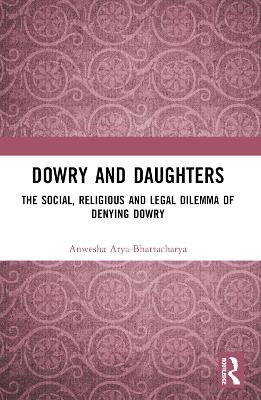
Dowry and Daughters
Routledge India (Verlag)
978-1-032-46025-3 (ISBN)
This book studies the relevance of dowry as a customary practice in Indian marriages. It examines the historical articulation between traditional cultural texts and modern statutory law to understand how daughters are valued and how dowry as a custom defines this value. The author creates a conceptual link between modern, medieval and ancient marriage rites that formulate and embed dowry behaviour and practice within Indian society. This book also provides a critique of the cultural textual tradition of India and South Asia. It asserts for the first time that Vedic materialism is at the core of an adequate understanding of how dowry as wealth comes to occupy such a central position in the field of marriage.
An important study into the custom and tradition of South Asia, this book will be indispensable for students and researchers of cultural studies, women’s studies, gender studies, religion, history, law and South Asian studies.
Anwesha Arya-Bhattacharya, an award-winning film academic, has taught cinema and creative writing widely. Anwesha has been Assistant Editor of South Asia Research (SAR), SAGE, and is a graduate of St Xavier’s College, where she edited the Bibliodelic (1993–1996). A Dorab Tata (1997) scholar, her pioneering Masters research at the School of Oriental and African Studies (SOAS), University of London, led to her PhD. She is the first female to be awarded the Research Student Fellowship (RSF) at SOAS. She has taught at SNDT University, Bombay, and University of Connecticut (London), where her course “Cinema as an Instrument of Social Change” exploring human rights, feminism and film proved popular. Anwesha has book chapters in Contemporary Stardom in Hindi Film, Madhumati, Janani, and Behind Closed Doors. Co-editor of the biographical collection Bimal Roy: The Man Who Spoke in Pictures (2017), she is also a published poet. Living with her actor husband and their four children in East Sussex, she now runs a small literary and film society. Anwesha lives with her actor husband and their four children in East Sussex, where she began an Arts & Crafts initiative the Paper Place in 2011 to support dying creative arts. She also runs a small literary and film society at the local cinema, converted from the old town library. She is the third child of Indian Women’s Movement pioneer and activist Rinki Roy Bhattacharya.
Foreword by Professor Werner F. Menski
Preface
List of Abbreviations
Introduction
Chapter One: Dowry and fatal auspiciousness
Chapter Two: Text and Context
Chapter Three: What is ‘good custom’ or sadācāra?
Chapter Four: Legal texts, religious rites and social traditions
Chapter Five: The phantom of dowry in context and text
Chapter Six: Ancient marriage expectations and the Ṛgveda
Chapter Seven: Dowry in ancient marriage arrangements
Chapter Eight: Anti-dowry law: A misguided strategy?
Chapter Nine: Dowry as sadācāra becomes dharma
Bibliography
Index
| Erscheinungsdatum | 20.02.2023 |
|---|---|
| Zusatzinfo | 2 Line drawings, black and white; 2 Halftones, black and white; 4 Illustrations, black and white |
| Verlagsort | London |
| Sprache | englisch |
| Maße | 156 x 234 mm |
| Gewicht | 480 g |
| Themenwelt | Sozialwissenschaften ► Politik / Verwaltung ► Politische Theorie |
| Sozialwissenschaften ► Soziologie ► Gender Studies | |
| Sozialwissenschaften ► Soziologie ► Mikrosoziologie | |
| ISBN-10 | 1-032-46025-3 / 1032460253 |
| ISBN-13 | 978-1-032-46025-3 / 9781032460253 |
| Zustand | Neuware |
| Haben Sie eine Frage zum Produkt? |
aus dem Bereich


